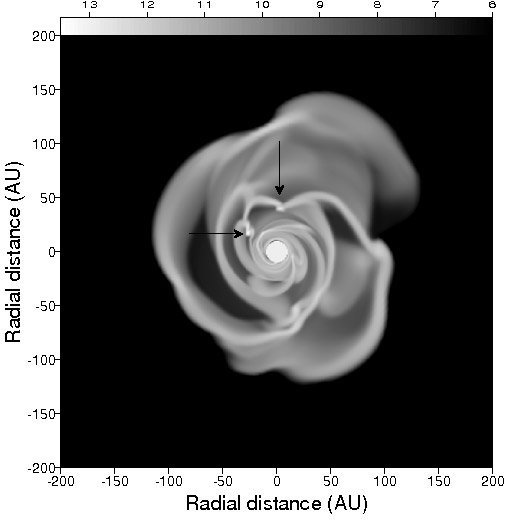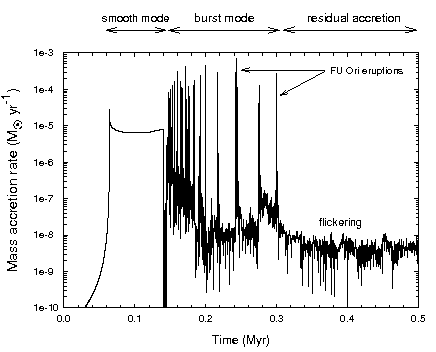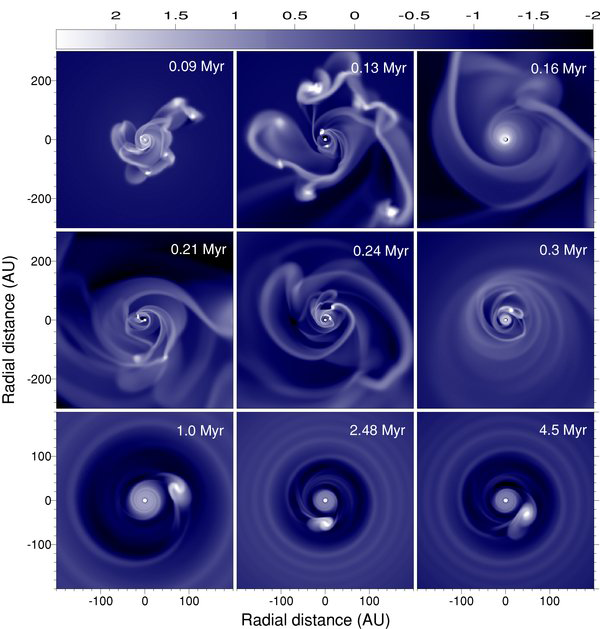The Migrating Embryo Model of Disk Evolution
 Through a series of papers with rigorous self-consistent calculations of the formation and evolution of protostellar disks, we are promoting a new view of disk evolution. This Migrating Embryo model has implications for many aspects of star and planet formation, including the formation of stellar and substellar (brown dwarf and planet) systems, luminous outbursts of young stellar objects, and the growth of dust and high-temperature processing of materials. Our defining result is that the early evolution of a disk is crucially affected by the continuing mass loading from the core envelope, and is driven into recurrent phases of gravitational instability. Nonlinear spiral arms formed in the disk during these episodes fragment to form gaseous clumps.
Through a series of papers with rigorous self-consistent calculations of the formation and evolution of protostellar disks, we are promoting a new view of disk evolution. This Migrating Embryo model has implications for many aspects of star and planet formation, including the formation of stellar and substellar (brown dwarf and planet) systems, luminous outbursts of young stellar objects, and the growth of dust and high-temperature processing of materials. Our defining result is that the early evolution of a disk is crucially affected by the continuing mass loading from the core envelope, and is driven into recurrent phases of gravitational instability. Nonlinear spiral arms formed in the disk during these episodes fragment to form gaseous clumps.  These clumps generally migrate inward due to gravitational torques arising from their interaction with a trailing spiral arm. Clumps that migrate all the way to the center will lead to mass accretion and luminosity outbursts (Vorobyov & Basu 2005, 2006). Occasionally, a clump can open up a gap in the disk and settle into a stable orbit, revealing a direct pathway to the formation of companion stars, brown dwarfs, or giant planets (Vorobyov & Basu (2010a). At other times, when multiple clumps are present, a low mass clump may even be ejected from the system, providing a pathway to the formation of free-floating brown dwarfs and giant planets in addition to low mass stars (Basu & Vorobyov (2012). Finally, it has been suggested that the inward migration of gaseous clumps can provide the proper conditions for the transport of high-temperature processed solids from the outer disk to the inner disk, and even possibly accelerate the formation of terrestrial planets in the inner disk. All of these features arising from clump formation and migration can be tied together conceptually in a Migrating Embryo model for disk evolution that can complement the well-known Core Accretion model for planet formation.
These clumps generally migrate inward due to gravitational torques arising from their interaction with a trailing spiral arm. Clumps that migrate all the way to the center will lead to mass accretion and luminosity outbursts (Vorobyov & Basu 2005, 2006). Occasionally, a clump can open up a gap in the disk and settle into a stable orbit, revealing a direct pathway to the formation of companion stars, brown dwarfs, or giant planets (Vorobyov & Basu (2010a). At other times, when multiple clumps are present, a low mass clump may even be ejected from the system, providing a pathway to the formation of free-floating brown dwarfs and giant planets in addition to low mass stars (Basu & Vorobyov (2012). Finally, it has been suggested that the inward migration of gaseous clumps can provide the proper conditions for the transport of high-temperature processed solids from the outer disk to the inner disk, and even possibly accelerate the formation of terrestrial planets in the inner disk. All of these features arising from clump formation and migration can be tied together conceptually in a Migrating Embryo model for disk evolution that can complement the well-known Core Accretion model for planet formation.
 In a series of papers (Vorobyov & Basu 2005, 2006, 2007, 2008), we modeled the collapse of a rotating prestellar core past the formation of a central point mass (represented by a central sink cell of size 5-10 AU). The subsequent evolution was followed for several Myr, and we were able to study the evolution of the centrifugal circumstellar disk as it was accreting matter from the envelope, as well as transporting matter to the central sink. Our calculations were the first to explicitly demonstrate the phenomenon of envelope-induced gravitational instability, a process that had been speculated upon in the literature much earlier ( Kenyon et al. 1990). The gravitational instabilities led to the formation of clumps which were subsequently accreted to the center, and provided an explanation for the observed FU Ori burst phenomenon. Fig. 2 (right) shows the time evolution of the accretion rate onto the central sink. In addition to a series of rapid accretion bursts in the early evolution, the residual accretion at late times settles down to a value (~ 10-8Msunyr-1) typical of observed T Tauri disk accretion. A further study (Vorobyov & Basu 2008) shows that a range of residual accretion rates, when compiled for models of different starting masses, can nicely explain the observed dM/dt vs M* correlation. While this empirical agreement with observational data is appealing, a deeper theoretical insight that emerges from this work is that mass flow toward the star is driven (even up to the late stages of disk evolution) by the self-gravitational effect of persistent density inhomogeneities in the disk. These nonaxisymmetric fluctuations persist to late times due to the "swing-amplifier" effect, which is enhanced by the presence of a relatively sharp disk edge.
In a series of papers (Vorobyov & Basu 2005, 2006, 2007, 2008), we modeled the collapse of a rotating prestellar core past the formation of a central point mass (represented by a central sink cell of size 5-10 AU). The subsequent evolution was followed for several Myr, and we were able to study the evolution of the centrifugal circumstellar disk as it was accreting matter from the envelope, as well as transporting matter to the central sink. Our calculations were the first to explicitly demonstrate the phenomenon of envelope-induced gravitational instability, a process that had been speculated upon in the literature much earlier ( Kenyon et al. 1990). The gravitational instabilities led to the formation of clumps which were subsequently accreted to the center, and provided an explanation for the observed FU Ori burst phenomenon. Fig. 2 (right) shows the time evolution of the accretion rate onto the central sink. In addition to a series of rapid accretion bursts in the early evolution, the residual accretion at late times settles down to a value (~ 10-8Msunyr-1) typical of observed T Tauri disk accretion. A further study (Vorobyov & Basu 2008) shows that a range of residual accretion rates, when compiled for models of different starting masses, can nicely explain the observed dM/dt vs M* correlation. While this empirical agreement with observational data is appealing, a deeper theoretical insight that emerges from this work is that mass flow toward the star is driven (even up to the late stages of disk evolution) by the self-gravitational effect of persistent density inhomogeneities in the disk. These nonaxisymmetric fluctuations persist to late times due to the "swing-amplifier" effect, which is enhanced by the presence of a relatively sharp disk edge.